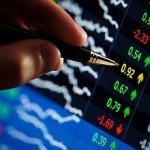Why You Should Look At the Stock Market Big Picture

Today we’ll show you a disturbing picture.It’s not for the faint hearted.Don’t worry.It’s not violent or bloody.But it’s enough to send a shiver down any investor’s spine…There’s one thing that all investors fear — a stock market crash.
That’s entirely understandable.
When you invest, you hope to buy low and sell high. Actually, that’s not true. You really hope to just buy low.
In a perfect world that’s all you’d need to do. Buy a stock and then keep hold of it as it keeps going up, up, up.
But it’s not a perfect world. Sometimes things happen…sometimes the market crashes. Sometimes all the ‘paper’ profits you’ve clocked up in a winning stock turn to dust as the market slumps.
No one wants that to happen. That’s why everyone is always looking out for the next market crash. But what if investors overestimate the impact of a crash?
What if it turns out that the ‘bark’ of a stock market crash is frequently worse than its ‘bite’?
A spine-chilling chart
If you’re a long time Money Morning reader you’ll know that we’ve railed against the ongoing series of fake crises that have worried the market.
We won’t go through them all again. To do so would involve listing various countries that have gotten into a pickle that the mainstream claimed would cause stocks to crash.
Only, stocks didn’t crash. That was because the big so-called problems highlighted by the mainstream turned out to be big bags of nothing.
But let’s not be complacent. Sometimes stocks do crash. You may remember one of the most famous stock market crashes of all time, the 1987 stock market crash.
Here’s a chart of the US S&P 500 index from 1986 through to 1988:
Source: Google Finance
Click to enlarge
Spine chilling, right?
That’s what we call a crash. The US market dropped 22% in one day. From top to bottom the market crashed more than 30% in a few weeks.
It’s no wonder that so many investors fear a market crash. But here’s the thing. While it may look scary close up, over the long term, the 1987 crash doesn’t look so scary after all:
Source: Google Finance
Click to enlarge
As you can see, when you take a step back, the crash — while frightening at the time — is barely a blip compared to the longer term stock market price performance.
Bull market rebound
This is where we get to the important point. At the time of the 1987 market crash, people painted a dire picture for the future. As the New York Times reported at the time:
‘[33] eminent economists of various leanings [share] a common, ominous view. “Unless more decisive action is taken to correct existing imbalances at their roots,” they say in a joint statement, “the next few years could be the most troubled since the 1930’s.” If leaders would only listen as often as they proclaim.’
Sounds familiar doesn’t it.
The New York Times opinion piece highlights the main problems of the time, ‘deficits in America, slow growth in Europe and Japan.’
Again, it all sounds familiar. Except that, rather than years of pain, the US market gained 550% over the next 13 years.
But it’s not just the language from the newspapers of the day that sound familiar. More important is whether stock charts 20 years from now will make the 2008 crash look like a tiny blip on the chart, just as the 1987 crash looks today.
It all seems so improbable. After all, the 2008 meltdown was the big one. It was the crash that saw the death of capitalism. Only, maybe it wasn’t.
Maybe, like the 1987 crash, it was an event that felt big at the time. It was an event that purged the market of most (but not all) of the bad elements that caused the crash.
There is always a tendency to think that everything that’s happening now is the best or worst that it has ever been.
But for those looking for signs of a crash, well, it’s worth looking at the long-term chart that includes the 1987 crash. And it’s also worth taking into account this report into stock valuations…
Above average returns
Regardless of the chart, there will always be those who say stocks are expensive and in a bubble.
When they refer to a bubble they’ll most often look back to 2000 or 2007 stock valuations for a comparison.
So, are stocks in bubble territory? Not according to this report from Bloomberg:
‘Stocks are catching up to the pace of more than a decade ago amid record profits, near-zero interest rates and economic growth that’s expected to accelerate. While the dot-com bubble peaked with the S&P 500 trading at close to 30 times annual earnings of its companies, the valuation is about 19 times now, data from S&P Dow Jones Indices show.’
In other words, stocks are expensive compared to historical valuations, but not excessively so.
And also remember that an average is an average because it’s an average…if you get what we mean. At any point in time, valuations will almost always be above or below the average. That’s how you derive an average.
But just because something is above an average doesn’t automatically mean that a crash in on the cards.
Statistically, something can remain higher or lower than the average for a considerable time. And importantly, the average isn’t a constant. It changes. If US stocks are 19-times earnings today, what’s to say the P/E ratio can’t go higher if investors expect improved earnings?
Or what’s to say P/E ratios can’t fall if company earnings catch up to the extended stock prices?
Anything can happen. All we’ll say is that folks shouldn’t be too quick to call the top of the market or bubbles. We dare say that, after the market recovered the lost ground two years after the 1987 crash, experts warned of another crash.
As they did so, the stock market began one of the biggest rallies of all time, which lasted another 11 years.
Bottom line: we’re not saying a crash is out of the question. But we are saying that sometimes it pays to put things in perspective. Think about what could happen if we’re right and interest rates and stimulus stay on the agenda for decades to come.
We don’t know about you, but such a scenario has bull market written all over it. That’s why we continue to buy stocks.
Cheers,
Kris+
PS: The US market closed this morning above 2,000 points for the first time ever. A new bull market is underway. Here’s how you can play it…
Already a subscriber to Money Morning… or simply, just like what you’re reading? Then show your support and spread the word…Share this post on…TweetShare
Bio
Google+
Latest Posts
Kris Sayce
Kris is never one to pull punches when discussing market developments and economic events that can affect your wealth. He’ll take anyone to task — banks, governments, big business — if he thinks they’re trying to pull a fast one with your money. Kris is also the investment director for
Australian Small-Cap Investigator
,
and
. If you’d like to more about Kris’ financial world view and investing philosophy then
. It’s where he shares investment insight, commentary and ideas that he can’t always fit into his regular
Money Morning
essays.
Read more about Publisher and Investment Director Kris Sayce.
+Kris Sayce
Latest posts by Kris Sayce (see all)
Make Sure You’re in Stocks as Another Record Falls… – 28 August 2014
Why You Should Look At the Stock Market Big Picture – 27 August 2014
How Cyber Warfare is a Threat to Financial Markets – 26 August 2014
The Three Steps to Avoiding Hyperinflation – 25 August 2014
We Hope You Followed Our Australian Share Market Advice… – 21 August 2014
Read this article:
Why You Should Look At the Stock Market Big Picture
See which stocks are being affected by Social Media


